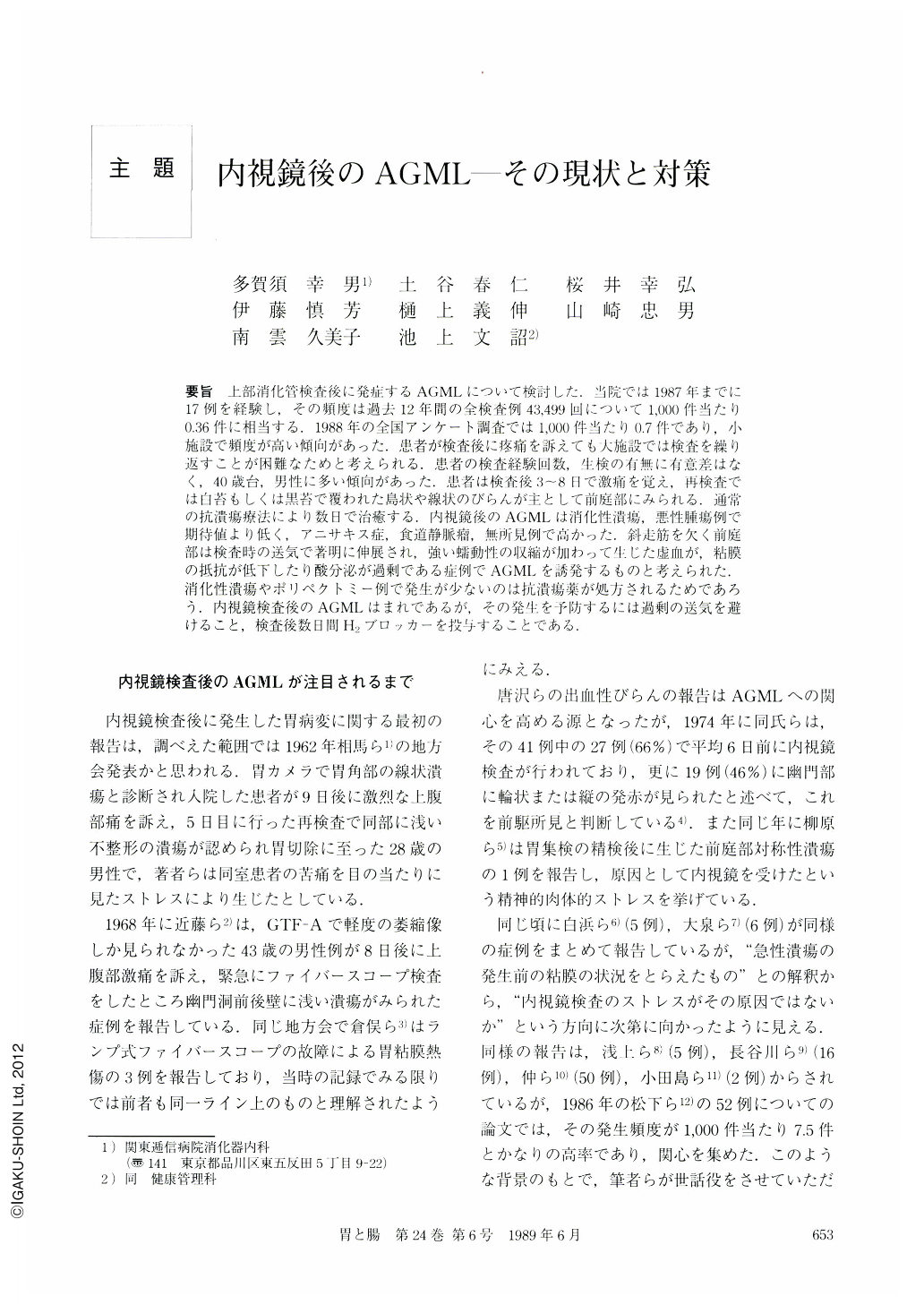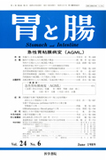Japanese
English
- 有料閲覧
- Abstract 文献概要
- 1ページ目 Look Inside
要旨 上部消化管検査後に発症するAGMLについて検討した.当院では1987年までに17例を経験し,その頻度は過去12年間の全検査例43,499回について1,000件当たり0.36件に相当する.1988年の全国アンケート調査では1,000件当たり0.7件であり,小施設で頻度が高い傾向があった.患者が検査後に疼痛を訴えても大施設では検査を繰り返すことが困難なためと考えられる.患者の検査経験回数,生検の有無に有意差はなく,40歳台,男性に多い傾向があった.患者は検査後3~8日で激痛を覚え,再検査では白苔もしくは黒苔で覆われた島状や線状のびらんが主として前庭部にみられる.通常の抗潰瘍療法により数日で治癒する.内視鏡後のAGMLは消化性潰瘍,悪性腫瘍例で期待値より低く,アニサキス症,食道静脈瘤,無所見例で高かった.斜走筋を欠く前庭部は検査時の送気で著明に伸展され,強い蠕動性の収縮が加わって生じた虚血が,粘膜の抵抗が低下したり酸分泌が過剰である症例でAGMLを誘発するものと考えられた.消化性潰瘍やポリペクトミー例で発生が少ないのは抗潰瘍薬が処方されるためであろう.内視鏡検査後のAGMLはまれであるが,その発生を予防するには過剰の送気を避けること,検査後数日間H2ブロッカーを投与することである.
With the increasing use of panendoscopy as the first line examination of the upper gastrointestinal tract, occurrences of AGML following panendoscopy begun to be reported from some institutions in our country. In our hospital the first case was indentified in 1984 and 17 cases in total were experienced by the end of 1987 (Fig. 1). Frequency is calculated as 0.73 per 1,000 examinations after 1984 or 0.39 per 43,499 examinations which were carried out in the past 12 years. It occurred more frequently in male (0.48 per 1,000) than in female (0.21 per 1,000) as shown in Table 1.
These patients ranged in age 23 to 59 years, most frequent in 40s (Fig. 2). AGML developed after the first examination of panendoscopy in 8 cases and after the second examination in 4 cases. The frequency of AGML, however, was unrelated to the number of examination performed (Table 2). No seasonal change was noted. The frequency of AGML was 0.37 for the examination without biopsy and 0.43 for that with biop-sy. Among endoscopists who performed over 3,000 examinations, the frequency of AGML ranged from 0 to 0.9 (Table 4).
In nationwide study using questionnaire in 1988, 129 hospitals or clinics answered that they never experienced such a case but 50 institutions reported 420 cases with the frequency, 0.7 cases per 1,000 panendoscopic examinations. It was experienced more often in small hospitals and clinics with highest, 7.59 cases per 1,000 examinations (Tables 5 and 6). This phenomenon may reflect in part the difficulty to repeat examination in larger institutions when a patient complains abdominal pain after panendoscopy.
Patients in most cases start to feel severe pain 3 to 8 days after panendoscopy. Urgent repeat examination reveals island-like or linear erosions covered by black or white coat mostly in the antrum (Figs. 3 and 4). Conventional anti-ulcer treatment is effective in rapidly relieving the symptoms with the lesions healing within several days. Almost invariable clinical course and distribution of the lesions suggest a cause-and-effect relationship between panendoscopy and the AGML.
At the endoscopy in which AGML occurred afterwards, no abnormality was the most frequent finding followed by mild erosive change (Table 3). The frequency of AGML after panendoscopy was lower in cases with gastroduodenal ulcer and gastric malignancy than expected, and higher in cases with anisakiasis, esophageal varices, gastric erosion and no abnormal findings (Table 7).
The antral wall which lacks oblique muscle layer is distended markedly during endoscopy by insufflation. Furthermore, peristaltic contraction tends to be strong in the antrum. Ischemia of the antrum caused by these factors during endoscopy is likely to lead to the development of AGML especially when it is accompanied by low mucosal resistance or hypersecretion of acid. Low frequency of AGML following panendoscopy in patients with peptic ulcer may be explained by the use of anti-ulcer agents which are usually prescribed when ulcer is detected. Although the stomach is often overinflated at polypectomy, no AGML is reported afterward. This may also be explained by the use of anti-ulcer drugs.
AGML after panendoscopy occurs rarely but the most important obstacle for the popularization of panendoscopy. The measures against the development of AGML may be to avoid over-insufflation of the stomach and to administer H2-blocker for several days after panendoscopic examination.

Copyright © 1989, Igaku-Shoin Ltd. All rights reserved.


